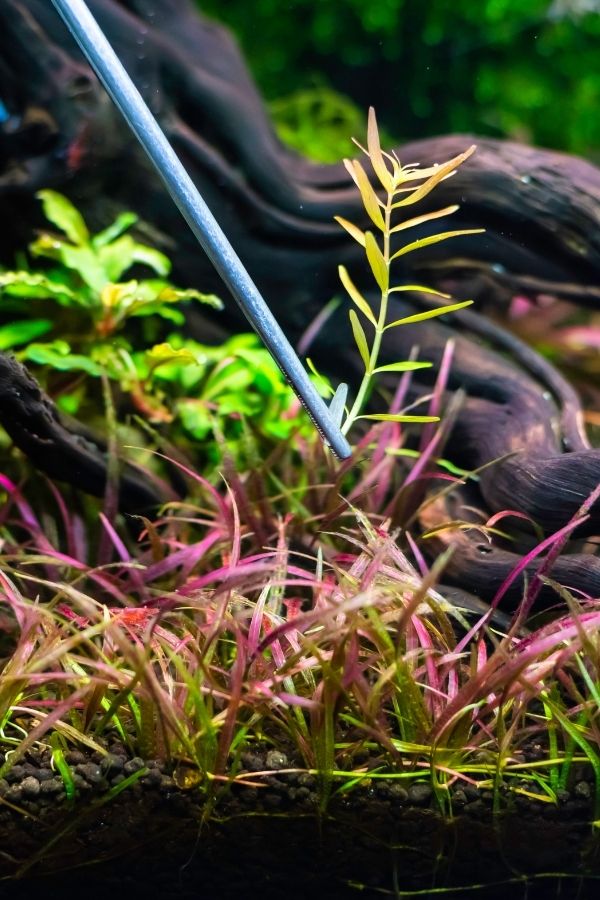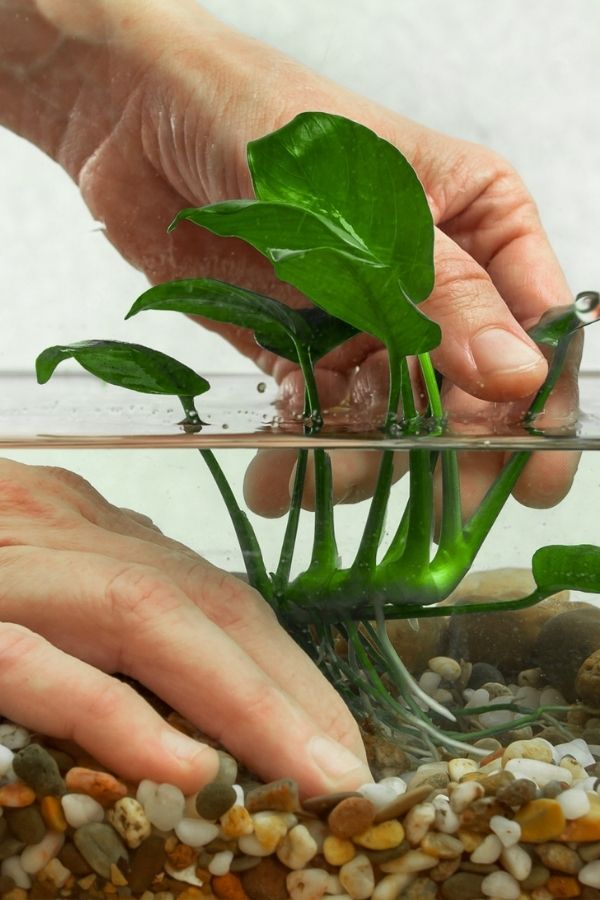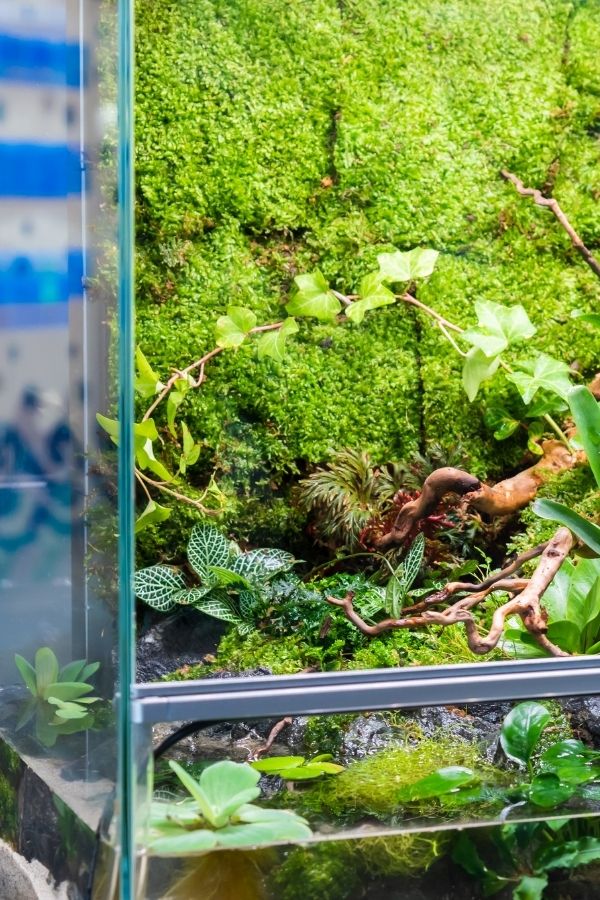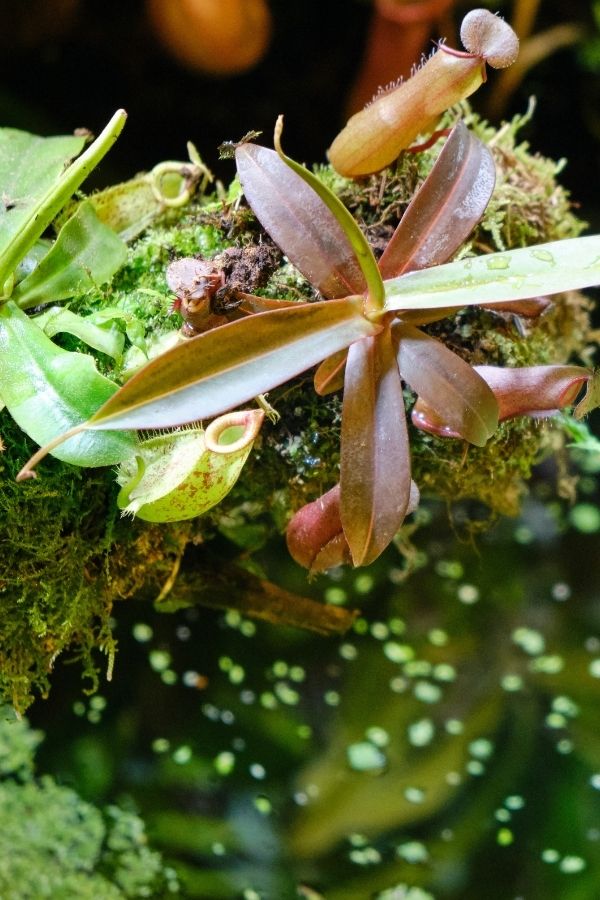Finding suitable paludarium plants is actually super easy.
Being such a versatile landscape of land and water, pretty much anything tropical goes if you have the proper setup in place!
The real challenge is knowing which species will thrive in particular conditions, and how to use them to their fullest (both individually and together) to create a beautiful and healthy landscape.
Come with me as we cover the four major types of paludarium plants and deep dive on each to discover what to look out for – along with my top picks.
Ready? Let’s go.

Terrarium Tribe is reader-supported. When you purchase through links on our site, we may earn an affiliate commission (at no further cost to you). 💜
Choosing the Best Paludarium Plants for Your Setup
Okay, with such a wide variety of plants on offer, let’s start by narrowing down your search.
As an extension of a terrarium with aquatic elements, we’re mainly looking at tropical species. Those that are going to thrive in warm and humid conditions with plenty of moisture (duh).
That said, the “best paludarium plants” are going to be unique to you and your vision.
Here are some things to consider:
- How much land vs. water will your landscape have? This will dictate your ratio of terrestrial plants to semi-aquatic plants and help you figure out which kind of plants you might need to fill the space (e.g., grasses vs. foliage).
- What kind of biome do you want to create? A lush rainforest jungle will need very different plants from an island archipelago. You don’t need a grand vision at this stage, just an idea and an intention.
- Are you adding a terrestrial animal to your environment? You’re going to need non-toxic and probably quite resilient plant species to handle being trampled on all day long.
- How large is your paludarium tank? Bigger tank = bigger plants. Simple.
With this framing in mind, we can start to hone in on the right plant species.
But don’t worry, this is only as complicated as you want to make it. There are plenty of paludarium plants for beginners to choose from.
Paludarium Plants List
Here, we’re deep-diving into each of the main types of paludarium plants.
Covering everything from the aquatic species for your water scene to the terrestrial plants that’ll fill out your “land” section – and everything in-between (which is actually quite a lot).
Let’s dive in.
Aquatic
Starting from the bottom up, these are the submerged species that you’ll be planting directly into the substrate underneath the water.
Honestly, there’s a vast array of potential aquarium plants out there (quite literally hundreds). Still, we can narrow them down to fit our needs based on a couple of simple principles.
- 1. As a half-water, half-land setup, your water will likely be much shallower than that of a typical aquarium. So, you’ll probably only need smaller aquatic plants to fill the space.
- 2. Unless you’re an experienced aquascaper, you’ll probably want to go with the more straightforward and easier plant options. I recommend choosing a selection of what’s often called “low-tech plants.” These plants handle low-light conditions well and don’t need a fancy CO2 injection system. Why make life more complicated?
That should really streamline the process.
Next, you’ll want to think about what kind of aquatic plants you need. Some are better for filling an area with density, whereas others are more effective highlights.

Here are a few recommendations to get you started.
- Carpeting plants – Lilaeopsis brasiliensis looks just like miniature grass! The “Micro Sword,” as it’s also called, is full of texture and relatively easy to grow in low-tech conditions. Great for filling in the gaps and creating an underwater carpet.
- Foliage plants – Check out the many species of Java Fern (Microsorum pteropus) for a wide range of textured foliage plants in all sizes. Honestly, there are lots of other great choices here, but many fit better into the semi-aquatic species listed in the next section!
- Floating plants -“Floating Crystalwort” (AKA Riccia fluitans) is a lovely delicate plant that floats either on top of or just underneath the water. Plus, shrimp love it too, apparently.
If you’re looking to build a more aquatic-focused tank with just a little bit of land, you might want to expand your tech and your options.
Either way, I’d recommend this aquatic plant guide from Green Aqua on YouTube for a deeper look.
Semi-Aquatic Plants
Next, we’re onto the (in-between) semi-aquatic plants.
These are the most versatile of the bunch because these amazing plants – under the right conditions – can happily grow in and out of water.
Amazing right?
It’s what we call growing a plant “emersed” in water, where the roots are beneath the water, but the foliage is above. This practice has several benefits, from better CO2 absorption (from the air) to fewer algae and pest challenges.

But, the main draw of these marginal plants is being able to naturally plant up the boundaries from aquatic to terrestrial – making sure every section of the build looks vibrant and alive!
Plants that can do this are often labeled as “riparium plants,” as they’re naturally found in riparian areas (the wetlands next to rivers and streams).
Here are some great examples to use:
- Carpeting – Some common carpeting plants like Hemianthus callitrichoides (Dwarf Baby Tears) grow better emersed than underwater in a low-tech tank. So, these can be used to great effect in creating a lush green carpet in the marginal areas around the waterline.
- Foliage plants – So much to choose from! The versatile Cryptocoryne plants (e.g., C. lucens) come with stunning blade-like leaves on long stems. Or, consider the tiny Bolbitis ‘Difformis‘ water fern for your highlight spots.
- Epiphytic plants – Plants of the Anubias and Bucephalandra genera are both full of adaptable mid-sized species. Often with gorgeous, deep emerald leaves and crisp, compact foliage. Though, it’s important to note that epiphytes should not have their rhizomes buried in the substrate.
- Mosses – Even aquatic mosses like Java Moss (Taxiphyllum barbieri) or Christmas Moss (Vesicularia montagnei) can happily grow out of the water, provided they have access to a lot (seriously, a lot) of moisture and humidity.
Terrestrial Plants
Now, onto the land!
You have a wide variety of tropical plants available to you, provided that you’re able to maintain lots of humidity or have a system in place to provide consistent moisture, e.g., a mister or a fogger.
Seeing as a paludarium is inherently a wet place (it comes with the territory, really), it makes sense to pick a range of terrestrial species that thrive in moist environments.

1 | Ferns
For me, ferns are the natural choice.
How about some dynamic Nephrolepis Sword Ferns or vibrant Davallia species? You can use the delicate dwarf varieties like the Fluffy Ruffles Fern to fill in the gaps or go all-in on the larger specimens like the Crocodile Fern (Microsorum musifolium) that are otherwise hard to fit in a terrarium.
Even the notoriously challenging Maidenhair Ferns seem to thrive in this wet environment!
2 | Vines
Tropical vine varieties would be my next go-to type of plant.
For larger setups, Monstera, Syngonium, and Philodendron are solid choices. They’re all pretty bulletproof, and they thrive in consistent moisture.
Look to the Ficus and Pilea families for some great miniature vine options, e.g., Ficus pumila or Pilea depressa.
Or practically anything from the Selaginella genus, all of these would quickly form a dense network of vining foliage.
3 | Foliage
There are many good foliage terrestrial plant options – especially if you have space for the bigger ones.
Even popular houseplants like Spider Plants and the Peace Lily would work great here.
Begonia, Peperomia, and Pilea (e.g., Pilea involucrata and the Moon Valley Pilea) are all great options from the more typical terrarium plants. You can’t go wrong with Fittonia for a splash of color, either!
Hell, you can even try a carnivorous plant here and there, like a Sundew, if you’re feeling bold.
Epiphytes
Last but by no means least come the epiphytic plants.
These adaptable plants can grow attached to your rocks and driftwood branches to bring the upper levels of your paludarium to life.
Neoregelia Bromeliad species make excellent rainforest additions with their bold, colorful leaves and intricate rosettes. Or, the vining tendrils of the Tillandsia Air Plants can add some spice to your hardscape.

Both are pure epiphytes, but many of the plants on this list have a dual-functionality as an epiphyte and a terrestrial plant or semi-aquatic plant.
- From the aquarium plants, we’ve already mentioned the Anubias, Bucephalandra, and Bolbitis. All of which can be grown entirely out of water.
- From the terrestrial plants, the Rabbit’s Foot Fern, vines like the Ficus pumila, and pretty much all Peperomia are epiphytic!
Of course, they all tend to need lots of humidity to thrive. But that’s not too difficult to achieve in a terrarium or paludarium setup.
Where to Find Paludarium Plants for Sale
When looking for aquatic and semi-aquatic plants, I’d recommend buying from Buceplant.com.
They have a range of Low Tech Plants that can be filtered by difficulty – making the choosing process so much easier. You can even find them pre-attached to driftwood so that you can plonk them right into your tank.
For everything else, I always look to Etsy.
With a diverse range of sellers, there are always plenty of great options to choose from. Check out “My Favorites” lists to get some ideas.
Now It’s Your Turn
Finding the right balance of paludarium plants is a lot like composing a symphony.
You need the variety, the highs, and the lows, and most of all, you need them to harmonize perfectly. After reading this guide, you’re well on your way with any luck.
Need some ideas for your project? Check out our paludarium ideas list.
Or, if you’re ready to get started on your project, check out my complete DIY paludarium guide and our online terrarium shop!
